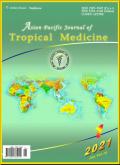中国广州恙虫病患者基因型与临床特征的相关性
IF 1.9
4区 医学
Q3 PUBLIC, ENVIRONMENTAL & OCCUPATIONAL HEALTH
引用次数: 0
摘要
目的 探讨恙虫病Orientia(O. tsutsugamushi)基因型与恙虫病患者临床特征的相关性。 通过病历收集2012年9月至2016年12月期间广州市各类医疗机构收治的恙虫病患者的临床资料。对不同基因型感染者的人口学数据、临床表现以及血液学和生化指标进行分析和比较。 本研究共纳入192例患者,其中包括121例恙虫病卡帕基因型感染患者(63.0%)、36例吉利安基因型感染患者(19.0%)、23例加藤基因型感染患者(12.0%)和12例TA763基因型感染患者(6.0%)。卡普基因型感染患者的白蛋白中位值明显低于吉利安感染患者(P=0.032)。卡普基因型感染患者的住院时间(9 天)明显长于吉利安基因型感染患者(7 天)(P=0.009)和加藤基因型感染患者(6 天)(P=0.005)。卡普感染者也是复杂器官受累最多的患者(88/133,66.2%)。此外,卡氏感染者出现多器官功能障碍综合征(18.2%)和需要重症监护室治疗(15.9%)的风险更高。此外,Gilliam 基因型(8 天)和 TA763 基因型感染者(7.5 天)的发热持续时间分别短于 Karp 基因型(9 天)和 Kato 基因型(9 天)感染者。 恙虫病Orientia的基因型与不同的临床表现、器官受累和治疗结果有关,这表明基因型的毒力各不相同。本文章由计算机程序翻译,如有差异,请以英文原文为准。
Correlation between genotypes of Orientia tsutsugamushi and clinical characteristics of patients with scrub typhus in Guangzhou, China
To explore the correlation between genotypes of Orientia (O.) tsutsugamushi and clinical characteristics of scrub typhus patients.
Clinical data of patients with scrub typhus admitted to different types of medical institutions in Guangzhou from September 2012 to December 2016 were collected using medical records. Demographic data, clinical manifestations, as well as hematological and biochemical indicators of patients infected with different genotypes were analyzed and compared.
A total of 192 patients were included in this study, including 121 patients with Karp genotype of O. tsutsugamushi infection (63.0%), 36 patients with Gilliam genotype (19.0%), 23 patients with Kato genotype (12.0%), and 12 patients with TA763 genotype (6.0%) infection. The median value of albumin in patients with Karp genotype infection was significantly lower than that of Gilliam-infected patients (P=0.032). Patients with Karp genotype infection had a significantly longer hospital stay (9 days) than those with Gilliam genotype (7 days) (P=0.009) and Kato genotype infection (6 days) (P=0.005). Karp-infected patients also represented for the largest number of patients with complicated organ involvement (88/133, 66.2%). Furthermore, Karp-infected patients had higher risk of developing multiple organ dysfunction syndrome (18.2%) and requiring intensive care unit treatment (15.9%). Besides, patients with Gilliam genotype (8 days) and TA763 genotype infection (7.5 days) had shorter fever duration than those with Karp genotype (9 days) and Kato genotype (9 days) infection, respectively.
Genotypes of Orientia tsutsugamushi were associated with varying clinical manifestations, organ involvement, and treatment outcomes, suggesting that genotypes ranged in virulence.
求助全文
通过发布文献求助,成功后即可免费获取论文全文。
去求助
来源期刊

Asian Pacific journal of tropical medicine
PUBLIC, ENVIRONMENTAL & OCCUPATIONAL HEALTH-TROPICAL MEDICINE
CiteScore
4.00
自引率
9.70%
发文量
1936
审稿时长
3-8 weeks
期刊介绍:
Asian Pacific Journal of Tropical Medicine (ISSN 1995-7645 CODEN: APJTB6), a publication of Editorial office of Hainan Medical University,is a peer-reviewed print + online Monthly journal. The journal''s full text is available online at http://www.apjtm.org/. The journal allows free access (Open Access) to its contents and permits authors to self-archive final accepted version of the articles on any OAI-compliant institutional / subject-based repository.
APJTM aims to provide an academic communicating platform for international physicians, medical scientists, allied health scientists and public health workers, especially those of the Asia-Pacific region and worldwide on tropical medicine, infectious diseases and public health, and to meet the growing challenges of understanding, preventing and controlling the dramatic global emergence and re-emergence of infectious diseases in the Asia-Pacific.
The journal is proud to have an international and diverse editorial board that will assist and facilitate the publication of articles that reflect a global view on tropical medicine, infectious diseases and public health, as well as emphasizing our focus on supporting the needs of public health practitioners. The APJTM will allow us to seek opportunities to work with others who share our aim, and to enhance our work through partnership, and to uphold the standards of our profession and contribute to its advancement.
 求助内容:
求助内容: 应助结果提醒方式:
应助结果提醒方式:


